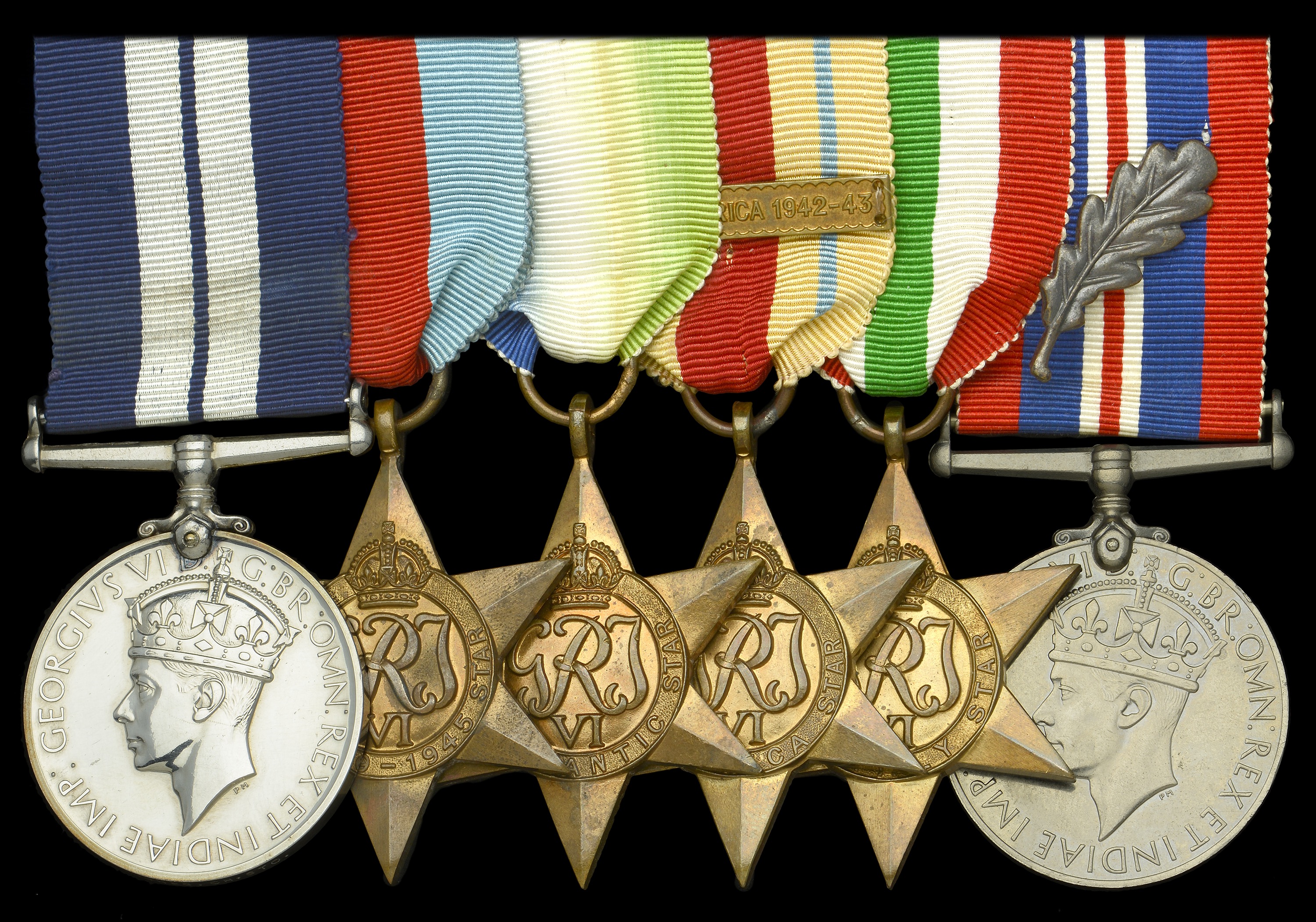A fine Second War ‘Malta Convoy’ D.S.M. group of six awarded to Stoker Chief Petty Officer C. E. Hughes, Royal Navy, for services when H.M.S. Kingston was hit by a 15-inch shell and later sunk whilst undergoing repairs in Malta Dockyard, Hughes being wounded in the same air raid; he had previously received a mention in despatches having been recommended for the D.S.M. Distinguished Service Medal, G.VI.R. (K.58629 E. C. Hughes. Ch. Sto.) impressed naming; 1939-45 Star; Atlantic Star; Africa Star, 1 clasp, North Africa 1942-43; Italy Star; War Medal 1939-45, with M.I.D. oak leaf, mounted as worn, extremely fine (6) £1,400-£1,800 --- D.S.M. London Gazette 8 September 1942” ‘For gallantry, skill and seamanship in H.M. Ships... Kingston... in a brilliant action against strong enemy forces which were driven off and severely damaged. This action resulted in the safe passage to Malta of an important convoy.’ The recommendation states: ‘For fine leadership, initiative and devotion to duty as senior rating of damage control parties when the ship was hit by a 15” shell. Through his efforts and organising ability a fire which might have proved serious was extinguished before it had a chance to get out of control.’ In his report to the Admiralty Commander Philip Sommerville, D.S.O., D.S.C., R.N., records: ‘I have the honour to report my proceedings during and after the action between the convoy escort and enemy surface forces during the passage of convoy MW10 from Alexandria to Malta. A Divisional torpedo attack was launched at an enemy Battleship accompanied by three Cruisers. These forces engaged the Division with main and secondary armaments. At 1846 Kingston was hit by a 15-inch shell which passed through the whaler on the starboard side, through No. 2 Boiler Room intake and the S.R.E. Room, and exploded under the port Oerlikon Platform. Shortly after managing a turn to fire our torpedoes the ship stopped. Before the enemy Battleship passed out of view she was seen to be on fire forward and the explosion of one torpedo was observed. The widespread damage to Kingston was quickly got under control by prompt and resourceful action by all hands. The fire in the S.R.E. Room was extinguished remarkably quickly. Nearly all the Torpedo tubes crew were killed or wounded and on the 4-inch gun deck no one escaped injury. Casualties were also sustained on the Oerlikon and searchlight platforms and at ‘X’ gun. One officer and fourteen ratings were killed and one officer and twenty ratings wounded. By 1905 the Kingston was able to proceed on the starboard engine at 16 knots which later increased to 20 knots. I proceeded independently to Malta. I entered Malta Harbour at 0838 on 23 March.’ Commander Philip Somerville was the son of Vice-Admiral H. C. Somerville and was killed in an air raid on Malta on Saturday 4 April 1942, along with one other officer and ten ratings, Chief Petty Officer Hughes being wounded in the same raid. Lieutenant G. J. Kirkby, D.S.C., later wrote to Hughes from H.M.S. Saunders on 29 October 1942:- ‘Dear Hughes, I was delighted to read your name among those in the recent list of awards for our action in March. Please accept my heartiest congratulations. It is a shame we are not still all happily together to celebrate in the old style in the Wardroom. I could then thank you personally for the splendid work you did on that occasion, and for your continuous hard work and efficiency and unfailing loyalty to all of us throughout all that grand commission. Are you recovered from the injuries you received in April? It nearly broke my heart to lose the Captain and so many friends, and to think of the old ship being so remorsely attacked during that unhappy period. I have been out of Destroyers since that time, but hope to go back very soon. Again let me congratulate you and wish you good luck.’ In his report to the Admiralty Lieutenant J. Cartwright, R.N., in temporary command of Kingston, wrote of her loss on 11 April 1942, when she received another direct hit which broke her back and she sank: ‘I regret to report the loss of H.M.S. Kingston under my command. The ship was dive bombed and sank in No. 4 Dock, being hit on the torpedo tubes by a bomb of heavy calibre. The ship had previously been hit by a bomb on 8 April , which caused extensive damage.’ M.I.D. London Gazette 11 June 1942, for services aboard H.M.S. Kingston (downgraded D.S.M. recommendation). Edward Charles Hughes was born in Hackney, London, on 21 January 1902, and entered the Royal Navy as a Stoker 2nd Class at Victory on 24 March 1920. He joined Royal Sovereign on 19 October 1920, followed by Victory II, 28 January 1921; Champion, 19 March 1921; Vivacious, 3 July 1921; Victory II, 1 July 1922; Centurion, 21 August 1922; Dolphin, 7 January 1924; H.M. Submarine H27, 9 February 1924; H.M. Submarine Ross, 15 March 1924; H27, 25 April 1924; L53, 20 June 1924; L56, 1 July 1926; H23, 12 May 1928, in which boat he was advance to Stoker Petty Officer, 20 December 1928, reverting to General Service again and joining Warspite on 23 January 1929; Frobisher for Saladin, 4 September 1931; Victory II, 3 November 1932; Milford, 20 December 1932; Victory II, 1 January 1935, and received his L.S. & G.C. medal on 22 June 1935; Curacoa, 10 August 1935; Courageous, 5 May 1936; Winchelsea, 31 August 1937; Victory II, 21 April 1938; and finally Kingston, 15 September 1939. Stoker Chief Petty Officer Hughes was invalided out on 16 March 1943. Sold with original M.I.D. certificate, dated 11 June 1942, and original letter to Hughes from Lieutenant Kirkby, as quoted above, together with copied record of service to 1929, Admiralty reports and London Gazette entries.


